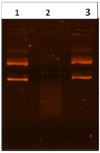Wild Vitex agnus-castus L.: Phytochemical Characterization, Acute Toxicity, and Bioactive Properties
- PMID: 37446759
- PMCID: PMC10343858
- DOI: 10.3390/molecules28135096
Wild Vitex agnus-castus L.: Phytochemical Characterization, Acute Toxicity, and Bioactive Properties
Abstract
Wild Vitex agnus-castus (VAC) is a Mediterranean plant that is rich in bioactive metabolites. This study aimed to validate, for the first time, the beneficial use of VAC fruits and fruit decoctions (VFDs) through in vitro and in vivo trials. Forty-one volatile components were detected in VAC fruits, with 1,8-cineole (30.3%) comprising the majority. The antioxidant activity of VFD was measured by using different in vitro methods (EC50 of 0.16 mg/mL by β-carotene bleaching inhibition assay) and by measuring the DNA protection power. Using the disc diffusion assay, the antimicrobial activity of VFD was evaluated, and it exhibited a noticeable anticandidal activity. VFD did not cause any toxicity or mortality in rats treated with doses > 200 mg/kg. Using the acetic acid writhing test, the antinociceptive activity of VFD was measured. Our results showed that VFD at 200 mg/kg exhibited a higher analgesic activity (81.68%) than acetylsalicylic acid used as a positive control (74.35%). Its gastroprotective ability was assessed by HCl/ethanol-induced gastric lesions, which were remarkably inhibited (84.62%) by intraperitoneal administration of VFD. This work helps to validate the popular use of VAC to treat nociceptive, inflammatory, and gastric disorders and encourages researchers to further investigate the identification of pharmacological compounds from this species.
Keywords: HS-SPME/GC-MS; Vitex agnus-castus L.; acute toxicity; analgesic; anti-inflammatory; antioxidant capacity; gastroprotective potential.
Conflict of interest statement
The authors declare no conflict of interest.
Figures


References
-
- Şen G., Akbulut S., Karaköse M. Ethnopharmacological study of medicinal plants in Kastamonu province (Türkiye) Open. Chem. 2022;20:873–911. doi: 10.1515/chem-2022-0204. - DOI
-
- Moreira D.D.L., Teixeira S.S., Monteiro M.H.D., De-Oliveira A.C.A.X., Paumgartten F.J.R. Traditional use and safety of herbal medicines. Rev. Bras. Farmacogn. 2014;24:248–257. doi: 10.1016/j.bjp.2014.03.006. - DOI
MeSH terms
Substances
Grants and funding
LinkOut - more resources
Full Text Sources
Molecular Biology Databases
Miscellaneous

